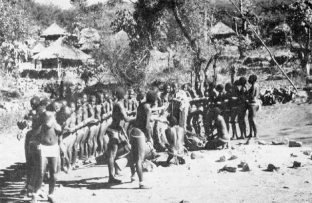
Domba at Thengwe, 1958.
|
|
| Domba was the third and final phase in Venda girls' initiation, which should have been attended after a girl had been to vhusha and tshikanda. It took place every three to five years at the head-quarters of chiefs and certain senior headman, and lasted for about one year. Its importance to the Venda was marked by the use of the bass drum (ngoma), which was also used in tshikona, the Venda national dance. There were a number of special rites and shows associated with domba, but its most notable feature was the great domba dance, performed regularly in the evenings. The girls formed a long chain (deu) and moved in a clockwise direction about the courtyard. The girls began with a monotonous response to the lead singer; then they broke into the ecstatic tivha khulo style of vocal hocketting; and at the end of the dance the girls stopped moving and would lean over toward the centre of the circle. The dance symbolised the mystical act of sexual communion, conception, the growth of the foetus, and child-birth. The successive performances of the dance during the months the school was in progress symbolised the building up of the foetus.
Domba at Thengwe, 1958.
|